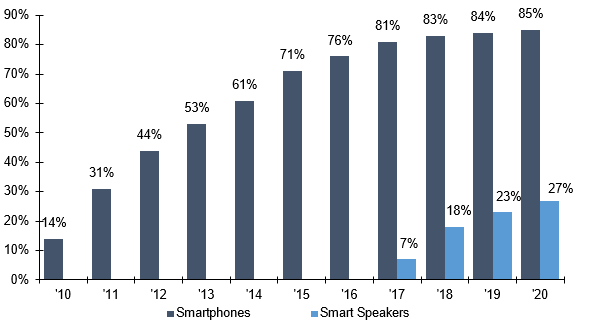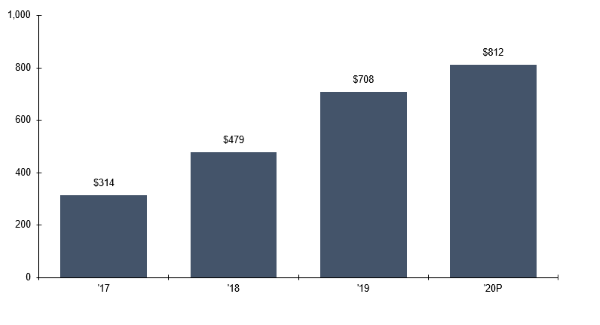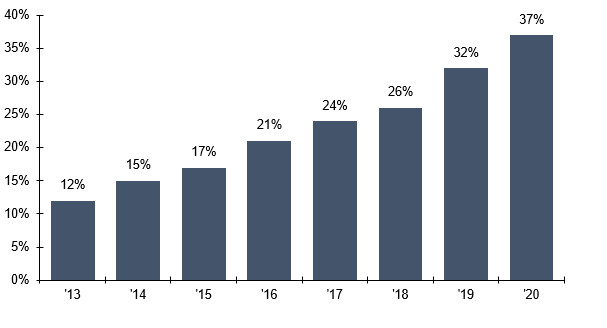Listen Up Podcasting on the Rise
Listen Up Podcasting on the Rise
The growing consumption of podcasts is driving M&A activity by large media companies.
Although the endless launch of video streaming services grabs most headlines these days, podcasting continues to garner a greater share of consumers’ attention. Podcasts are serialized audio episodes typically focused on particular topics or themes, including news, business, and sports. Their origin dates back to 2004, but gained mass-popularity with the publishing of the true-crime podcast "Serial" in 2014. Since that time, consumers have endeared themselves to this audible content format, with the percentage of U.S. population listening to podcasts on a monthly basis steadily increasing from 15% in 2014 to 37% in 2020 (an estimated 104 million people),[1] as shown in Figure 1.
Figure 1. Monthly Podcast Listening
% U.S. Population [a]
Source: The Infinite Dial 2020, Edison Research and Triton Digital
[a] Ages 12 and older
Figure 2. Smart Device Ownership
% U.S. Population Owning a Smart Device [a]

Source: The Infinite Dial 2020, Edison Research and Triton Digital
[a] Ages 12 and older
The growth in podcast consumption is primarily driven by two factors: smarter devices and more content.
As shown in Figure 2, approximately 85% of the U.S. population older than age 12 has a smartphone, which translates into roughly 240 million people. As podcasts are commonly enjoyed through smartphones, growth in U.S. podcast consumption has coincided with the saturation of smartphone ownership. Smart speaker adoption has also contributed to podcast adoption, with an estimated 76 million people in the U.S. owning a smart speaker in 2020 (i.e., 27% of the U.S. population age 12 and older).[2]
The proliferation of smart devices provides podcast publishers with an enticing addressable market. The sheer number of podcasts has exploded in recent years. In 2018, there were 525,000 active podcasts with more than 18.5 million episodes, but by April 2020 there were more than 1 million podcasts with more than 30 million episodes.[3]
Monetization
Since the launch of "Serial" in 2014, monetization of podcasts has improved dramatically. Podcasts typically generate revenue in one of two ways: advertising or subscriptions. Advertising revenue in particular has increased substantially in recent years, growing 52.6% and 47.8% in 2018 and 2019, respectively, and reaching $708 million in the U.S. Although dampened by the COVID-19 pandemic, advertising revenue is projected to increase 14.7% in 2020 to approximately $812 million,[4] as shown in Figure 3. The growth in advertising revenue reveals that advertisers believe podcasts are an effective way to reach their target audience. In fact, Forbes notes that popular podcasts can charge advertisers between $10 and $50 for every 1,000 listeners, nearly 2x-3x the ad rate for broadcast radio.[5]
Figure 3. U.S. Podcast Advertising Revenue
In Millions U.S. Dollars

Source: IAB U.S. Podcast Advertising Revenue Study, prepared by PwC, July 2020.
2020 projection accounts for the impact of the COVID19 pandemic.
The COVID-19 pandemic has materially impacted the podcast industry in 2020 as some advertisers have canceled or paused campaigns, reducing projected 2020 advertising revenue growth from 29.6% (pre-COVID-19) to 14.7%. However, the medium has remained more resistant than other media, due in part to advertisers favoring the news genre, the most popular genre among podcast advertisers (garnering 22% of podcast ad revenue), as well as the overall flexibility of the format in shifting ad messaging (host-read ads accounted for 66% of ad revenue in 2019).[6] Podcasting is poised to resume its explosive growth beyond 2020, with the IAB U.S. Podcast Advertising Revenue Study previously projecting U.S. ad revenue growth of 55% and 36% in 2021 and 2022, respectively, prior to the COVID-19 pandemic (projections for these years have not been revised as of the publication of this article).
Meanwhile, other podcasters shun advertising altogether and rely on subscriptions instead. Stitcher Premium, for example, offers ad-free podcasts on its platform for a $4.99 monthly subscription. Publisher Slate magazine, while offering free access to ad-supported podcasts such as "Slow Burn," also offers a subscription option for $6.00 per month, providing its subscribers with ad-free listening as well as exclusive access to premium content.
Merger and Acquisition Activity
Figure 4. Top Podcast Publishers
In Millions, Except Active Shows

Source: Podtrac, Inc.
The boom in podcasting has not gone unnoticed by large media companies. Many have entered the podcast market to provide another form of content to grow their subscriber-related revenues, with the list of top podcast publishers including a number of recognizable players in the media industry (Figure 4). The means of market entry differ, however. Companies like Sony Music, WarnerMedia, and Apple collaborate with podcast developers and fund their own exclusive podcasts, while others use mergers and acquisitions (M&A) to enter the space or grow within it. M&A activity has been accelerating since 2018 in recognition of the popularity of podcasting. Large audio streamer Spotify acquired three podcast publishing companies (Gimlet Media, Parcast, and The Ringer) as well as Anchor, a podcast technology company, during this time period. Entercom, with its portfolio of 235 radio stations, acquired podcast publishers Cadence13 and Pineapple Street Media to become a large player in the podcast industry. Most recently, satellite radio company Sirius XM announced a deal to acquire podcast platform Stitcher in a sizable bid to expand its presence in the podcast market, while newspaper publisher The New York Times Company acquired Serial Productions, the company behind the aforementioned "Serial" podcast.
With consumers increasingly tuning in to podcasts, large media companies are expected to continue to focus their attention on the format. Whether to gain an increased share of advertising revenue (such as the New York Times acquiring Serial Productions) or to offer new and exclusive content with the goal of attracting more subscribers (such as Spotify’s series of acquisitions), participants in the podcast industry will increasingly become more attractive acquisition targets to large media companies, as shown in Figure 5. Moreover, the market for podcasts is diversified: the top 10 podcast publishers account for only 1,100 of the estimated 1 million published podcasts. Thus, the occurrence of large media companies such as Spotify and Entercom consummating multiple acquisitions to gain meaningful market share may become more prevalent. Altogether, M&A activity is expected to remain strong in this burgeoning space.
Figure 5. Summary of M&A Transactions
In Millions of U.S. Dollars
Source: S&P Capital IQ, Inc. Includes transactions announced between July 31, 2018 and July 31, 2020.
EV=Enterprise Value; LTM=Latest Twelve Months
[a] Reflects the acquisition of a 36% interest.
[b] Revenue multiples reflect projected next fiscal year revenue as of the transaction date as reported by Podcast Business Journal.
- “The Infinite Dial 2020.” Edison Research and Triton Digital.
- Ibid.
- Ross Winn, "2020 Podcast Stats & Facts (New Research From April 2020),” Podcast Insights.
- “IAB U.S. Podcast Advertising Revenue Study,” PwC, July 2020.
- Brad Adgate, “Podcasting is Going Mainstream.” Forbes, November 18, 2019.
- “IAB U.S. Podcast Advertising Revenue Study,” PwC, July 2020.






